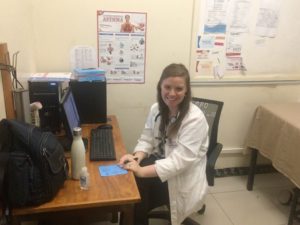Week 2: OPD
December 14th, 2019 by Elaina Truax Russo
This week we were seeing patients in OPD. This is the outpatient clinic for older children and adults. Like pediatrics, the visits are walk-in. The majority are acute visits , however, occasionally people would come in for a blood pressure check, medication refill, or hospital follow up visit.
It always is tough changing departments and starting fresh on the first day. The logistics of referring patients, knowing who to call if there is an emergency, which medications are available, etc. takes a few days to figure out. By the end of the week, however, we started to get the hang of things. We were thankful for the kind ladies in OPD who helped us find English-speaking patients and helped us figure out the flow of things.
One of the interesting logistical things we became more familiar with this week is how patients pay for treatment. This was a painful lesson to learn as it occurred while we were trying to do a lumbar puncture on a patient we were concerned may have cryptococcal meningitis. Before the procedure could be done, the patient had to go to the cashier and pay for the procedure and all the supplies including gloves and a spinal needle. Once payed, the procedure could be completed. As we were new to the process, the patient unfortunately had to go to the cashier a few times as we originally did not order the lab work (CSF fluid studies) that also needed to be payed for ahead of time. The patient took this all in stride and was very understanding. In some ways it makes sense to have patients pay up front as they are not stuck with a big medical bill at the end of the day, however, from a provider standpoint, it does slow the process down and it was difficult to learn the flow.
We often asked patients how far they had traveled to come to the hospital, out of curiosity. It was not uncommon to hear >5 hours and some said upwards to 12 hours. They often traveled the day before or overnight in order to arrive at the hospital early in the morning to get in the queue. Many were elderly or families traveling with small children. Many had also seen providers closer to home but were either referred to Kijabe for further care or were not having improvement in symptoms causing them to seek care elsewhere. One patient traveled 8 hours to be treated for an ear infection. Another patient was referred for a second opinion on constipation. Overall, many illnesses are similar to what we see in the US. However, there are differences. For some reason, DVTs and PEs are pretty common here. Breast cancer is fairly common and routine screening is not performed so women often come in with breast masses or similar concerns. Cervical cancer is common however the HPV vaccine is becoming somewhat more routine so hopefully this decreases in the future. Pap smears are actually fairly expensive (1250 KSH, or $12.50) compared to a TB test which is 250 KSH ($2.50).
On Tuesday, I had the opportunity to give a lecture to the interns about “chronic cough”. It was interesting to hear about some of the differences between workup and treatment in the US vs Kenya. In the US, we often think of “asthma, allergies, acid reflux, smoking” as common causes of chronic cough. Here, when I asked the interns what is on their differential for chronic cough, TB and PCP pneumonia were at the top of their list. To test for TB, instead of a PPD test, they use a Gene Xpert test which is very fast and cheap. Also, everyone gets the BCG vaccine (TB vaccine) here, so they were surprised to learn that their PPD test would come back positive if they were ever tested in the US.
On Thursday, the clinics were closed due to Kenyan independence day. We were on call and went to the hospital once that day for an admission. Overall, it was a nice day.
This weekend, we are on call as well. The time is going fast and we only have one week left. Next week, I will be on the inpatient service.



Sorry, comments for this entry are closed at this time.